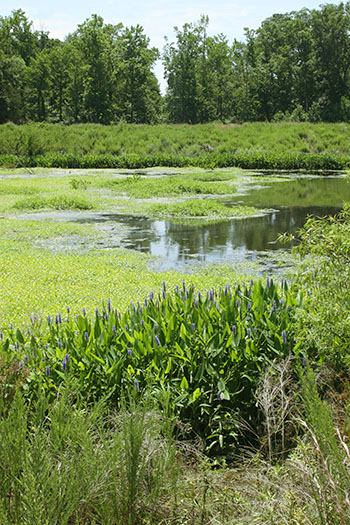 I mentioned in the previous post that I went someplace that I was going to feature here shortly; this is not the time. Since then, I did a short side trip and got a bunch of shots that I’m bumping ahead of those, because I want to, so there.
I mentioned in the previous post that I went someplace that I was going to feature here shortly; this is not the time. Since then, I did a short side trip and got a bunch of shots that I’m bumping ahead of those, because I want to, so there.
[Actually, I’ve been trying to sort through stacks of images, because I’m way behind on cataloging and have been trying to be conscientious or businesslike or something of that nature, but these deserved a post, so…]
The past few days have been very wet here, with rain appearing sporadically throughout the days and nights without any clearing, turning much of the area downright boggy but at least keeping the sweltering temperatures away. Knowing how these conditions tended to be favored by frogs, I popped down to the pond nearby and checked out the wetlands end of it. I can find no mention of any name for this, so I’ve taken to calling it Ederia Pond – you’ll see why if you’re alert.
The photo here was taken on an earlier visit when the light was a bit better – this day, it was solid overcast but not raining at the time. While they make various rain covers and splash guards for cameras, and some of the professional models advertise weather sealing, I have to recommend against using any camera (save for dedicated underwater models) in the rain; the humidity is just too pervasive, the electronics in any camera manufactured in the last thirty years too susceptible, not to mention the lenses. I carry disposable rain ponchos in the camera bags, big enough to cover me and the bags when a sudden downpour hits, but even then, I empty out everything when I get back to dry conditions and make sure no humidity has a chance to be retained. A wet bag can drive moisture into the equipment within easily, and that can be an expensive repair.
There was a patch of pickerelweed that was my prime target, and I waded in slowly, looking carefully for photo opportunities. It didn’t take a lot of effort. As suspected, the green treefrogs (Hyla cinerea) were enjoying the dripping, cooler, overcast conditions. Their skin must remain moist, so they typically find deep shade during the day, often near something that retains water, and maintain their primary activity at night, but in the right conditions they’ll remain visible during daylight.
 None of them were calling, and there was practically no activity until they deemed I was too close, but they were pretty easy to spot, and I saw dozens. Most were quite small, about half adult size or smaller, and a few sported the last vestiges of their tadpole tails, obviously this spring’s brood. While adults can get up to 5 or 6 centimeters, the average size is about 3, and the ones I was seeing typically ran 1 to 2 cm in body length. The longitudinal white stripe is a distinctive identifier, but in the right light, they gain a faint iridescence and a hint of gold in the white. As treefrogs, they have excellent adhesion to just about any surface and prefer to be vertical, usually selecting something as close to their body color as possible to perch upon – this means, when you’re out looking for them, you aim for the plants with the brightest green, preferably big leaves in or around water – pickerelweed (Pontederia) is thus ideal.
None of them were calling, and there was practically no activity until they deemed I was too close, but they were pretty easy to spot, and I saw dozens. Most were quite small, about half adult size or smaller, and a few sported the last vestiges of their tadpole tails, obviously this spring’s brood. While adults can get up to 5 or 6 centimeters, the average size is about 3, and the ones I was seeing typically ran 1 to 2 cm in body length. The longitudinal white stripe is a distinctive identifier, but in the right light, they gain a faint iridescence and a hint of gold in the white. As treefrogs, they have excellent adhesion to just about any surface and prefer to be vertical, usually selecting something as close to their body color as possible to perch upon – this means, when you’re out looking for them, you aim for the plants with the brightest green, preferably big leaves in or around water – pickerelweed (Pontederia) is thus ideal.
You’re going to see two different kinds of light quality in these images, as I switched back and forth between natural light and flash. I preferred natural light for the hue and the way the backgrounds remained lit the same as my subjects, but under heavy overcast and shooting handheld, I could only use maximum aperture lest the shutter speed drop too low to keep anything sharp. A tripod was out of the question – I was knee-deep in water most of the time over a silty bottom that had a tendency to try and steal my sandals, and the water plants were thick enough that I had enough trouble even finding a decent angle to shoot from without anything in the way.
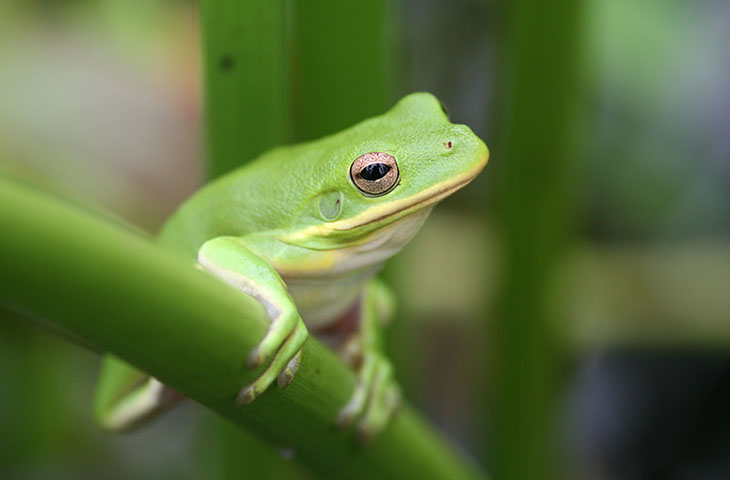
This is natural light, and you can see how short the effective focus is. The colors are pleasant and soft, and the background indicates accurate conditions, but if you want more body details you’re out of luck.
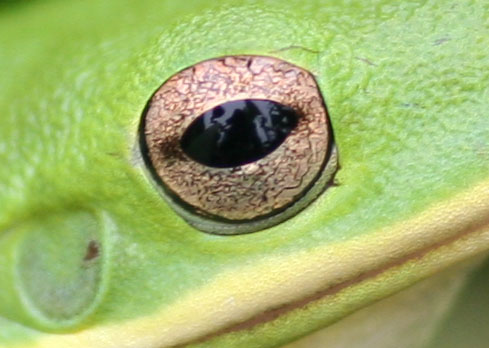 Now I’m going to pause here for a bit of interesting trivia before moving on. This is the same image cropped down to see the eye detail. You can’t quite make out the camera and I, due to the light being at my back as I aimed downwards, but you can see the flash on the bracket arm to the left, as well as plenty of other leaves surrounding me. These were typical conditions, and even leaning close for many of these shots meant I was disturbing stems and leaves which could send warning signals to the frogs. Progress was glacially slow, but that was okay, since I was surrounded by subjects.
Now I’m going to pause here for a bit of interesting trivia before moving on. This is the same image cropped down to see the eye detail. You can’t quite make out the camera and I, due to the light being at my back as I aimed downwards, but you can see the flash on the bracket arm to the left, as well as plenty of other leaves surrounding me. These were typical conditions, and even leaning close for many of these shots meant I was disturbing stems and leaves which could send warning signals to the frogs. Progress was glacially slow, but that was okay, since I was surrounded by subjects.
Using the flash typically increased contrast and, while bringing out the rich colors that green treefrogs have, often caused the background to drop into darkness and make many images appear to be taken at night. Since these are primarily nocturnal species anyway, this wasn’t as big a deal as if I was chasing dragonflies, for instance, so I didn’t worry about it too much. A softbox and/or an additional flash would have produced better results, but it was difficult enough preventing the one strobe from being blocked by leaves nearby. Here’s a good example of the difference – different subject, same pose (which you’re going to see again since it is the position treefrogs adopt when thinking the photographer is getting too close and they should probably find an avenue of escape.)
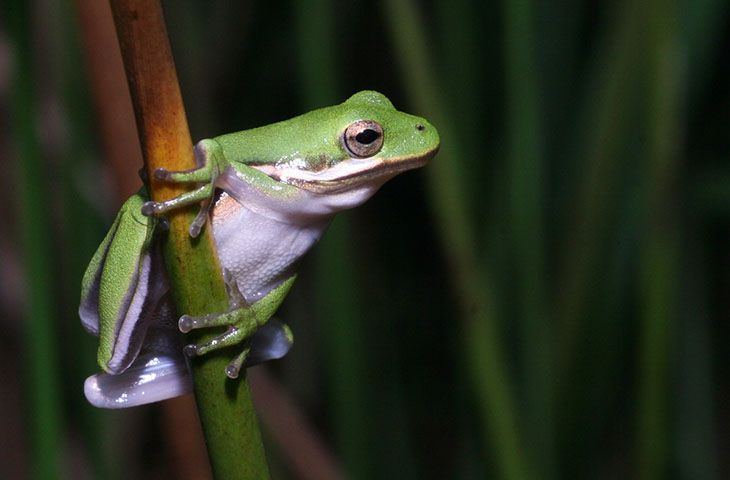
While the body details are much sharper at f16 (as compared to f4 in the natural light frame above) and the colors really glow now, the contrast is a bit unnatural-looking and the background becomes darker. Like I said, another strobe would have been useful, but unwieldy and likely blocked by leaves too often, throwing odd shadows across the subject or background. Sometimes obtaining the best results can require a lot of fiddling around – remember that every time you see a perfect nature photo. Looking natural or vivid often isn’t as effortless as it might seem.
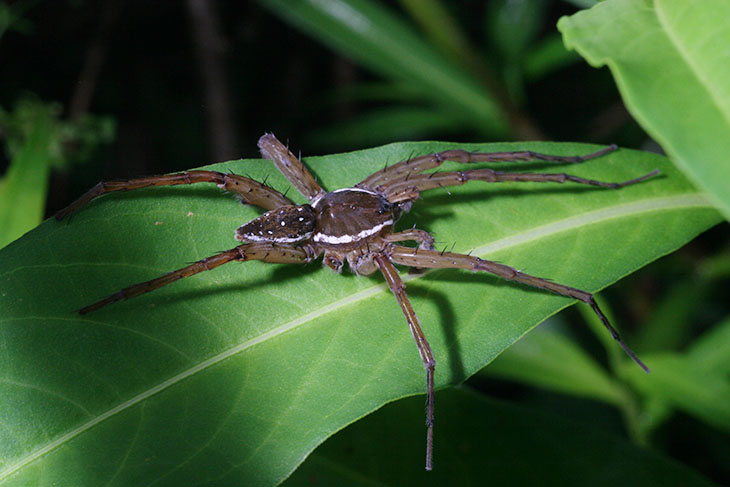
 Naturally, the treefrogs weren’t the only subject I chased while down there, and if you think I can go three days without photographing a spider, you haven’t read very far into this blog. The six-spotted fishing spider (Dolomedes triton) above wasn’t quite big enough to spread across my palm, but close. He’d seen me coming and sought refuge under the leaf, but I poked a finger underneath and flushed him back on top again. This might seem like I was inviting a bite, but I’ll say it again: spiders are shy, and typically avoid any kind of contact. The Eastern pondhawk (Erythemis simplicicollis) at right, meanwhile, not only didn’t care much about my presence, it almost seemed to follow me around – likely, I was seeing multiple dragonflies instead of the same one. I also shot a few tiny little damselflies and a remarkably colorful grasshopper of some sort, which I may feature a little later on.
Naturally, the treefrogs weren’t the only subject I chased while down there, and if you think I can go three days without photographing a spider, you haven’t read very far into this blog. The six-spotted fishing spider (Dolomedes triton) above wasn’t quite big enough to spread across my palm, but close. He’d seen me coming and sought refuge under the leaf, but I poked a finger underneath and flushed him back on top again. This might seem like I was inviting a bite, but I’ll say it again: spiders are shy, and typically avoid any kind of contact. The Eastern pondhawk (Erythemis simplicicollis) at right, meanwhile, not only didn’t care much about my presence, it almost seemed to follow me around – likely, I was seeing multiple dragonflies instead of the same one. I also shot a few tiny little damselflies and a remarkably colorful grasshopper of some sort, which I may feature a little later on.
And if you noticed the difference in pronouns above, yes, I know the spider is a male, while I don’t know what gender the dragonfly is. The spider’s club-ended pedipalps are just barely visible, but the abdomen being much smaller than the cephalothroax is also a clue, especially in an adult this size. Note, too, the shadow falling across the leaf behind the spider – this was caused by a stem blocking the flash unit where it sat to the left of the camera body on a bracket arm. On-camera flash is boring and flat looking, but in tight conditions, brackets come with their own problems.
Back to the frogs.
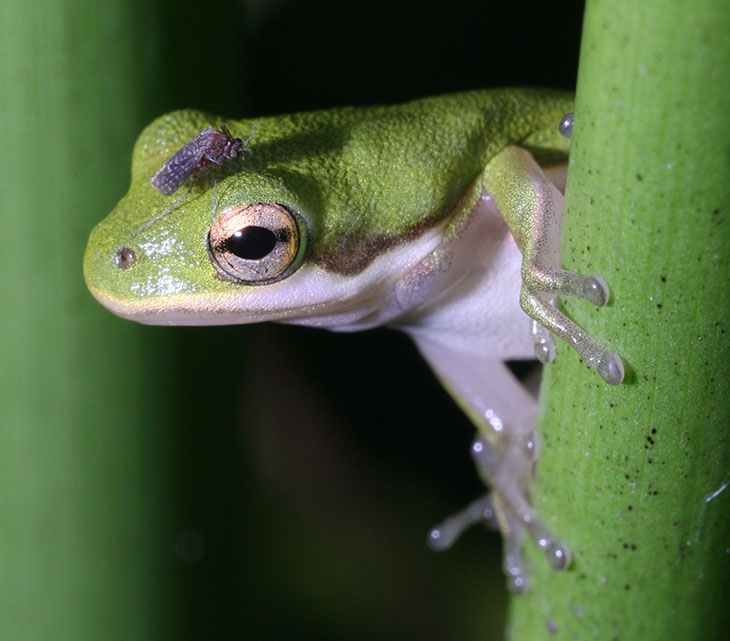
This minuscule specimen held still for quite a while, not only allowing me to keep creeping closer but also playing host to the fly on its head, likely some kind of parasite – it’s about the size of a mosquito but the wrong body shape. What I like most about it, though, is the single toe from the hind leg peeking past the stem near its back. If you think the color here is cool, just wait.
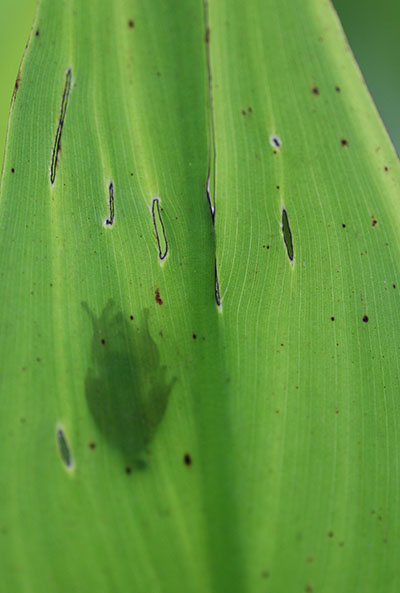 Had the sun peeked out suddenly, I might have been able to spot more examples like this, but it would have chased all of the frogs under cover quickly, so my window of opportunity would have been brief. Maybe I can capture some more examples of this right at sunrise some day – the last time I tried to catch sunrise at this pond, the day broke overcast for the first time in weeks – this was during the drought before the latest patch of downpours came along.
Had the sun peeked out suddenly, I might have been able to spot more examples like this, but it would have chased all of the frogs under cover quickly, so my window of opportunity would have been brief. Maybe I can capture some more examples of this right at sunrise some day – the last time I tried to catch sunrise at this pond, the day broke overcast for the first time in weeks – this was during the drought before the latest patch of downpours came along.
I had actually planned a little bonus for this post, in that I returned to the pond after nightfall and recorded some of the frogs’ calls – they’re pretty bizarre sounding, and I got within a meter of one while calling. The problem is, my digital recorder doesn’t pick up ambient sound very well so I have to use the ancient tape recorder, and at present I can’t locate the adapter cords I need to patch it into the computer’s sound recorder and reproduce it digitally. From time to time I think I should get a decent wildlife audio recording system (as well as branching into video,) but right now the nonexistent demand isn’t justifying the expense. I’ll put it up here eventually, but wasted too much time searching and got fed up.
I’ll close with perhaps the cutest image, where the strobe had the best effect…
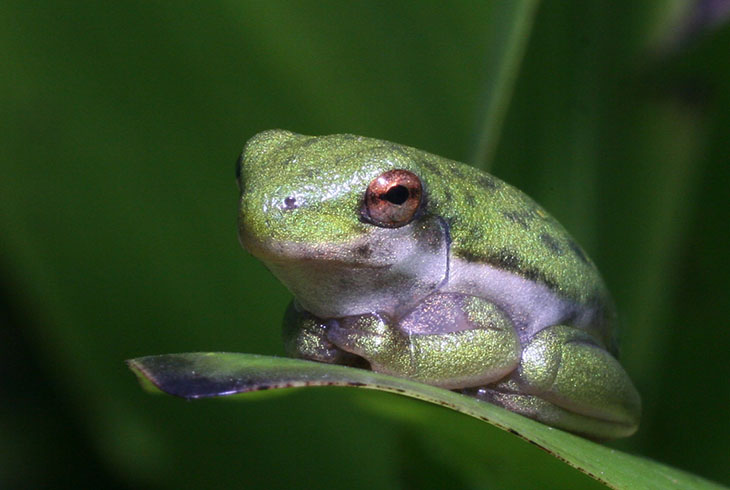
This little spud is about a centimeter long and still sports a nubby little tail. I had initially thought it looked similar to images I’d captured a few years before, but on examination, they don’t appear to be the same species.
Just remember, when chasing nature images, every set of conditions is ideal for something. If you’re worried about keeping clean, dry, or at a comfortable temperature, you’re liable to miss out on a lot. I came back dripping sweat, with damp, filthy shorts and a sandal that the mud had nearly sucked the sole clean off of, and a large collection of images to add to my stock. That’s more than a fair trade, I think.
UPDATE: I found the adapter cord I needed, and have created a sound file of the calls of the green treefrog. I give fair warning: this is still not an ideal recording unit, and the cacophony of background noise may be unsettling. For the latter call, I was within a meter of the treefrog.




















































